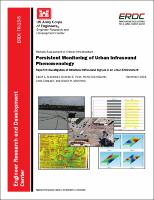Please use this identifier to cite or link to this item:
https://hdl.handle.net/11681/20428| Title: | Persistent monitoring of urban infrasound phenomenology; Report 2 : investigation of structural infrasound signals in an urban environment |
| Authors: | Pace, Michael E. Diaz-Alvarez, Henry Simpson, Christopher P. McKenna, Mihan H. McComas, Sarah L. |
| Keywords: | Acoustics Remote sensing--Data processing Signal processing--Mathematics Source separation (Signal processing) Cities and towns Infrasound |
| Publisher: | Engineer Research and Development Center (U.S.) Geotechnical and Structures Laboratory (U.S.) Information Technology Laboratory (U.S.) |
| Series/Report no.: | ERDC;TR-15-5 (Report 2) |
| Abstract: | Abstract: Historically, infrasound arrays have been deployed in rural environments where anthropological noise sources are limited. As interest in monitoring sources at local distances grows in the infrasound community, it is vital to understand how to monitor infrasound sources in an urban environment. Arrays deployed in urban centers have to overcome the decreased signal-to-noise ratio and the reduced amount of real estate available to deploy an array. To advance the understanding of monitoring infrasound sources in urban environments, local and regional infrasound arrays were deployed on rooftops of the campus of Southern Methodist University (SMU) to collect data for one seasonal cycle. The data were evaluated for structural source signals (continuous-wave packets). When a signal was identified, the back azimuth to the source was determined through frequency wavenumber analysis. This information was used to identify hypothesized structural sources; these sources were verified through direct measurement followed by structural numerical modeling. Wave propagation modeling was completed to understand how the urban infrastructure affects infrasound propagation by tying the direct source measurements to the original infrasound observations. The wave propagation study was focused on a single season. This study demonstrated that infrasound arrays deployed in urban environments could detect structural sources with success. |
| URI: | http://hdl.handle.net/11681/20428 |
| Appears in Collections: | Technical Report |
Files in This Item:
| File | Description | Size | Format | |
|---|---|---|---|---|
| ERDC TR-15-5 Report 2.pdf | 30.71 MB | Adobe PDF |  View/Open |